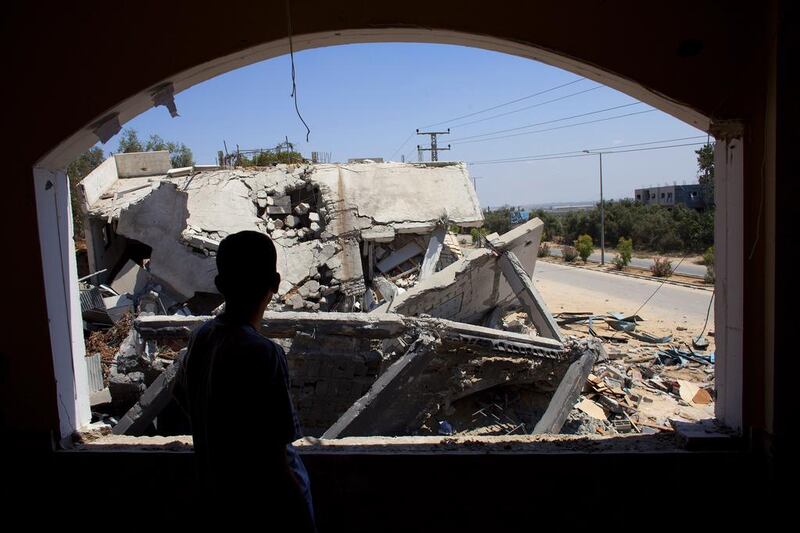GAZA STRIP // Flattened homes, disfigured mosques and destroyed livelihoods litter Saladin Street, Gaza’s main thoroughfare.
As talks continue in Cairo for a lasting ceasefire, The National travelled the road on Wednesday to document the devastation wrought by four weeks of relentless Israeli bombardment.
[ Interactive map: Follow Gaza’s road of desolation from Erez to Rafah crossings ]
Starting at the Hamas-controlled side of the Erez border crossing with Israel, Saladin runs the length of this tiny, besieged territory, ending roughly 45 kilometres away at the southern Rafah crossing into Egypt.
Parts of Erez were covered in debris from the Israeli artillery and airstrikes that began on July 8. Inside a building that was used as an inspection point for visitors to Gaza, rock and sand cover an X-ray machine used to check baggage. During the fighting, Hamas fighters were seen by journalists in the area firing rockets at Israel. The crater of a bomb the Israelis fired in response has left a crater at the centre of the building that threatens to make the structure collaspe.
Less than a kilometre down Saladin, three homes lining the western side of the two-lane highway were whittled away by what residents said were Israeli artillery and strikes by “F-Sita’sh”, the Arabic name for F-16 warplanes. One home, which neighbours said was owned by a man named Yahia Abu Haider, looked as if it had been crumpled by a giant hand. Its owner, like most other residents, had fled the area before Israel stepped up its bombardment.
Not far away, Sa’ed Al Kurd’s house – home to his children, grandchildren, and electrical appliance shop – was destroyed by Israeli artillery on the last day of Eid.
“We left our home like they [Israel] told us to, and then they destroyed it,” he said, in reference to Israeli warnings through leaflets and text messages that residents should leave the area.
Near the Shujaieh area of eastern Gaza City, Ghazi Mortaja, 52, said Israeli artillery and airstrikes had killed a dozen members of the Silik family in their home next to his fishing-supply store. Across the street from his shop were the remains of an apartment building and four shops.
“Where is Obama? Where is America in all of this?” Mr Mortaja yelled in anger.
Nearly 2,000 – mostly civilian – Palestinians were killed during the fighting, according to Gaza’s health ministry. Israel says 64 of its soldiers were killed, along with three civilians.
The destruction along Saladin Street, seen during a 72-hour ceasefire that began on Tuesday, highlighted the daunting effort that will be required to repair what may amount to billions of dollars in damage across the territory.
Driving through the more densely built-up areas of Gaza city, store fronts and apartments had holes blown in them by the bombing. At the Ardh Al Rebat Mosque in the Zeitoun area of the city, walls were pockmarked by the explosions but there were no casualties, neighbours said.
It appeared clear who the target was, however, even if only a symbolic one.
A propaganda poster for Islamic Jihad militant group, which fought Israel alongside Hamas, still clings to the mosque’s pockmarked walls. It showed a masked fighter wielding a machine gun and rockets being fired at Israel.
More than 3,200 rockets were fired by militant groups during the conflict, according to Israel’s military.
Yet, the purpose of many of Israel’s other attacks seemed less clear.
At the Al Awda biscuit factory in the central Gaza area of Deir Balah, workers cleared out the burnt inside of the plant. It had been hit by Israeli airstrikes and shells dozens of times, they said, at a loss to explain why.
“Biscuits don’t threaten anyone,” said Khaled Nabhan, one of the factory workers.
And, towards central Gaza, in the Bureij refuge camp area, at least four craters, some more than 10 metres wide, perforated the eastern edge of Saladin. The area is highlighted by orchards of olive trees and oranges. Places such as these have been used by fighters to launch rockets.
Further south, approaching the city of Rafah and the end of road, the asphalt has been ripped away by Israeli-tank tread and bulldozers.
Much of the debris ripped from the road had been piled into a large mound that blocked traffic in both directions, forcing vehicles to drive off the road to go around.
Yassin Abu Al Hussein, 20, was at a loss for why the Israelis had built the mound.
“This is war, and the Israelis do whatever they want in war,” he said.
hnaylor@thenational.ae
[ Interactive map: Follow Gaza’s road of desolation from Erez to Rafah crossings ]





